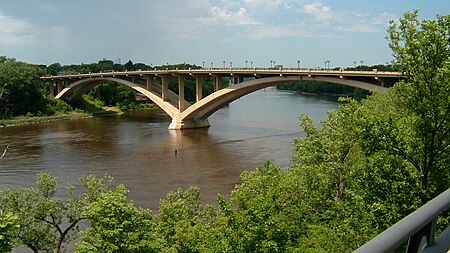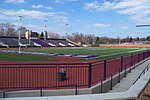Lake Street-Marshall Bridge
Bridges completed in 1889Bridges completed in 1992Bridges in MinneapolisBridges in Saint Paul, MinnesotaBridges over the Mississippi River ... and 6 more
Concrete bridges in MinnesotaHistoric American Engineering Record in MinnesotaMississippi GorgeOpen-spandrel deck arch bridges in the United StatesRoad bridges in MinnesotaShared-use paths in Minneapolis

The Lake Street–Marshall Avenue Bridge is a reinforced concrete arch bridge that spans the Mississippi River between Minneapolis, Minnesota and St. Paul, Minnesota. It is oriented east-west and connects Lake Street in Minneapolis to Marshall Avenue in St. Paul. St. Paul residents often refer to it as the Marshall Avenue Bridge. The bridge was designed by Howard, Needles, Tammen, and Bergendoff.
Excerpt from the Wikipedia article Lake Street-Marshall Bridge (License: CC BY-SA 3.0, Authors, Images).Lake Street-Marshall Bridge
West River Parkway Trail, Minneapolis Seward
Geographical coordinates (GPS) Address External links Nearby Places Show on map
Geographical coordinates (GPS)
| Latitude | Longitude |
|---|---|
| N 44.948525 ° | E -93.202286111111 ° |
Address
Sri Chinmoy Peace Bridge
West River Parkway Trail
55406 Minneapolis, Seward
Minnesota, United States
Open on Google Maps








